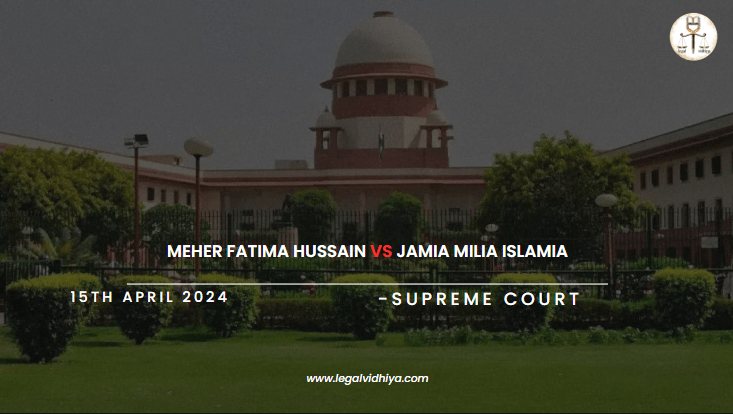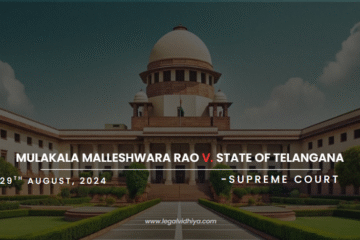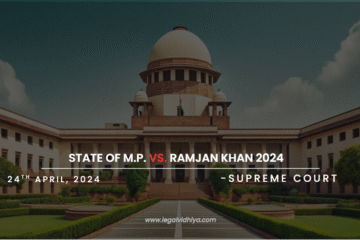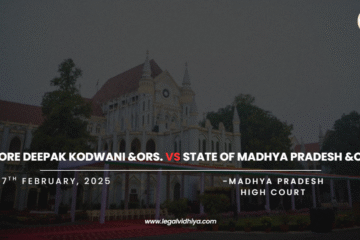
| CITATION | 2024 INSC 303 |
| DATE OF JUDGMENT | 15th April 2024 |
| COURT | Supreme Court of India |
| APPELLANT | Meher Fatima Hussain |
| RESPONDENT | Jamia Milia Islamia and Ors. |
| BENCH | J. Abhay S. Oka , J. Pankaj Mithal |
INTRODUCTION
In Meher Fatima Hussain v. Jamia Milia Islamia & Ors., there is a legal issue pertaining to the employment status of multiple professors at Jamia Milia Islamia University. The University made decisions,regarding the regularisation and termination of academic positions, and the University Grants Commission (UGC) followed up with judicial determinations. These decisions give rise to the appeals that are currently being considered. At Jamia Milia Islamia University, the appellants—Meher Fatima Hussain, Sabiha Hussain, and Suraiya Tabassum—were first assigned to academic positions within distinct centres under particular UGC schemes. Prior to being assigned to more permanent positions after proper selection procedures and appointment letters were issued, these appointments were made on an as-needed or temporary basis. The appellants encountered difficulties in having their positions regularised and ultimately terminated even after completing the standard selection processes. The case illustrates the intricate relationships that exist between formal regulations, procedural justice, and academic employment policy. In the end, the court will decide whether the appellants’ appointments—obtained through formal channels—should be considered permanent and shielded from sudden dismissal, or if the University had good reason to re-advertise their positions and respond to the misbehaviour charges. In their appeals, the appellants defend the legitimacy and equity of their initial selection and subsequent appointment procedures, aiming to reverse the High Court’s rulings that supported the University.
FACTS OF THE CASE
Information: Three appellants, Meher Fatima Hussain, Sabiha Hussain, and Suraiya Tabassum, are contesting the choices made regarding their appointments to Jamia Milia Islamia University (JMI).
- 1. At JMI’s Dr. K.R. Narayanan Centre for Dalit and Minority Studies, Sabiha Hussain was hired in 2008 as a Reader on probation. Under the University Grants Commission (UGC) Career Advancement Schemes, she was appointed Associate Professor on August 6, 2014, and then Professor. Her role as Director of the Sarojini Naidu Centre for Women Studies was extended to her on February 23, 2016. On December 8, 2016, she submitted an application to become the Sarojini Naidu Center’s Professor and Director. The UGC granted the University’s request to combine the Centre with the regular establishment. She was fired from her Director job on July 1, 2019, after being given a show cause notice for misbehaviour on June 26, 2019. Her removal was contested, and the High Court temporarily reinstated her. On April 1, 2020, the University reopened her post and shuttered the Sarojini Naidu Centre.
- On August 6, 2008, Meher Fatima Hussain was hired as a probationary lecturer. 2010 saw the conversion of her post to a temporary one. The UGC Career Advancement Scheme resulted in her being upgraded. She was hired on December 8, 2016, after submitting an application for the Associate Professor position at the Sarojini Naidu Centre. Like Sabiha Hussain, the University applied for and was granted UGC approval before merging the posts. On June 28, 2019, she was given a notice to show cause, and during her tenure, she encountered similar difficulties.
- On December 8, 2016, Suraiya Tabassum was named an Assistant Professor at the Sarojini Naidu Centre.Like with the previous appellants, the same procedure was followed. She was subject to comparable legal troubles and administrative measures.
- As per the ruling that their appointments were erratic and temporary, the High Court denied their appeals.
- The appellants filed an appeal with the Supreme Court, citing UGC guidelines and communications as proof that their appointments were regular and compliant with due process. According to the appellants, the University’s actions were unwarranted and their appointments were normal. For the regularisation of their posts, they depended on user-generated content communications.
- After the merger, the University argued that the appointments were subject to new selection procedures and were tenure-based. Additionally, they emphasised issues related to misconduct. For individuals recruited through appropriate selection procedures and fulfilling the necessary credentials, regularisation was allowed, according to the UGC.
ISSUES RAISED
- What effect did the appellants’ appointments as directors and faculty members at the Sarojini Naidu Centre have on their employment status? Were they deemed to be temporary or tenure-based positions?
- In compliance with the UGC’s rules and procedural criteria, was the University required to regularise the appellants’ positions based on their initial selection process and subsequent performance?
- When choosing and appointing the appellants, did the University adhere to the relevant legislative and procedural standards, and did any deviations from these standards make their appointments irregular or null and void?
- How legitimate and significant were the accusations of misbehaviour made against the appellants? Were the procedures followed fairly in their handling? Did the accusations have an effect on their requests for regularisation and job security?
CONTENTIONS OF APPELLANT
- 1. According to the University’s statutes, the appellants contended that their appointments were made through a duly constituted Selection Committee, fulfilling all relevant legal and procedural conditions.
- The individuals argued that since their appointments were determined by a regular selection procedure and they fulfilled the UGC’s requirements, the University Grants Commission (UGC) had granted authorization for the regularisation of their positions. Their argument was that the University’s failure to regularise their appointments was unfair and arbitrary, and the UGC’s communication had confirmed their eligibility for regularisation.
- Sabiha Hussain contested her sudden termination as director and the issuing of a show-cause letter due to suspected misbehaviour, claiming that these measures were punitive and lacked appropriate basis. They claimed that they were violated legally and that their removal and the University’s re-advertisement of their posts occurred without following the proper procedures.
- Regarding the regularisation of employees, the appellants argued that the High Court erred in applying the Supreme Court’s decision in STATE OF KARNATAKA v. UMA DEVI. They contended that, contrary to what Uma Devi intended, their case did not involve irregular or backdoor appointments.
- In order to support their continued employment and regularisation, they emphasised their extensive service history and contributions to the university, including their participation in teaching and administrative duties.
- According to the appellants, the regularity of the selection procedure that resulted in their appointments was not compromised by the term nature of their appointments, which were connected to the UGC plan period.
- They cited several court rulings in favour of regularising workers who were hired after a suitable hiring procedure, including State of Rajasthan & Ors v. Daya Lal & Ors and Asma Shaw v. Islamia College of Science & Commerce.
- The appellants argued that their claim for continuous employment without a new selection procedure was supported by the UGC’s constant insistence that those hired through a legitimate selection process should be regularised.
CONTENTIONS OF RESPONDENT
- According to the respondents, the appellants’ appointments were not permanent posts at the university because they were expressly granted on a tenure basis and were only valid for the duration of the particular UGC scheme or the XII Plan.
- The University argued that a new selection procedure was required to fill these jobs as permanent posts after the UGC approved the merger of the posts with the regular establishment. Regularisation was not assured by the preceding appointments.
- They emphasised that the appellants had been given show-cause warnings for misbehaviour. A three-person commission led by a former High Court judge discovered preliminary evidence of misconduct and suggested that a regular disciplinary body be established for more investigation.
- The response emphasised that the three-member committee’s recommendations—concerning the necessity for a new selection procedure as well as the misconduct accusations—had been adopted by the university’s Executive Council. The appellants had raised no objections to this resolution.
- They claimed that the appellants’ appointments did not adhere to the normal, open, and competitive hiring procedure necessary for posts that require permanent status. Regularisation would therefore be considered backdoor entry and would not be allowed without a new screening procedure.
- The participants provided clarification, stating that although the UGC permitted the consolidation of positions, it did not require the retention of employees appointed to tenure-track positions in the absence of a new hiring procedure. Following the correct selection procedures was a requirement for the UGC’s approval.
- They backed the High Court’s application of the legal precepts laid forth in STATE OF KARNATAKA v. UMA DEVI, contending that the appellants’ appointments were irregular and, as a result, did not meet the requirements for regularisation outlined by this case.
- The respondents contended that any regularisation of appointments would have to guarantee that the candidates fulfil all the requirements and standards set forth by the UGC, which calls for a new assessment through an official selection procedure.
JUDGEMENT
Appeals were allowed by the Supreme Court. The appellants filed a Letters Patent Appeals, but the High Court rejected them, and the Supreme Court maintained that decision. The appellants’ appointments were clearly tenure-based and binding for the life of the particular UGC scheme or the XII Plan period, as the Court upheld. Within the University, they were temporary appointments. In order to regularise the jobs following their merger with the legal establishment, the Supreme Court ruled that the University had right to demand a new selection procedure. According to the Court, regularisation did not follow automatically from prior appointments. Based on the findings of the three-member committee, the appellants had prima facie evidence of misconduct, which the court acknowledged. It agreed with the suggestion to form an ongoing Disciplinary Committee in order to carry out a comprehensive investigation. The Executive Council’s resolution, which the appellants did not contest, was deemed lawful by the Court. This resolution acknowledged the misconduct findings and the necessity of a new selection procedure. The UGC’s acceptance of the merging of posts into the regular establishment was subject to a proper selection process, as acknowledged by the Court. The UGC’s specified criteria and processes had to be followed in order for the appellants’ appointments to be made. The Supreme Court highlighted that regularisation would be illegal backdoor entry if it were to occur without an open, competitive selection procedure. The appellants’ irregular appointments did not deserve regularisation, and the Court agreed with the High Court’s application of the criteria set forth in State of Karnataka v. Uma Devi.
ANALYSIS
- The Supreme Court decided that the tenure appointments of the appellants, which were dependent on the duration of the UGC’s XII Plan or certain programmes, were only temporary and could not be regularised without a fresh hiring procedure. This emphasises how crucial employment contracts are for educational institutions, especially when they call for project- or temporary-based roles.
- The University’s decision to hold a new hiring process in order to integrate temporary positions into the permanent staff was maintained by the Court. In order to guarantee justice and meritocracy in regular appointments, it emphasised how important it is to have open and transparent selection procedures.
- The Court’s ruling was significantly influenced by the allegations of wrongdoing against the appellants. The Supreme Court emphasised the significance of responsibility and integrity in educational institutions when it noted that a committee had established prima facie evidence and urged a formal investigation.
- The significance of UGC compliance for the regularisation of academic employment was underscored by the Supreme Court. Regulation adherence is crucial because the permission for the merging of posts into the regular establishment required achieving certain requirements and going through a suitable selection process.
- The decision upheld the STATE OF KARNATAKA v. UMA DEVI guidelines, reiterating the prohibition on regularising appointments made outside of open, competitive selection processes. This ruling demonstrates the Supreme Court’s dedication to upholding the rule of law and the integrity of public hiring practices.
CONCLUSION
The appellants were appointed to tenure positions at Jamia Millia Islamia, which were linked to the UGC’s XII Plan period or specific projects, as confirmed by the Supreme Court of India, which supported the rulings of the lower courts in this matter. Rejecting the appellants’ demands for automatic regularisation, the Court underlined the importance of following a proper and competitive selection process for regularisation of these posts. The Court further emphasised the significance of upholding responsibility and integrity in academic institutions by endorsing the University’s response to the appellants’ accusations of misconduct. By establishing a strong precedent for instances that may arise in the future that are similar to this one, the ruling upholds the values of justice, meritocracy, and regulatory compliance in the hiring procedures of educational institutions.
REFERENCES
- SCC Online
- https://indiankanoon.org/doc/160923326/#:~:text=In%20the%20facts%20of%20this,to%20be%20continued%20after%20merger
- https://www.the-laws.com/encyclopedia/browse/case?caseId=004202303000&title=meher-fatima-hussain-vs-jamia-milia-islamia
- https://www.indianemployees.com/judgments/details/meher-fatima-hussain-versus-jamia-milia-islamia
- https://www.advocatekhoj.com/library/judgments/announcement.php?WID=17489
This Article is written by VEDIKA TIWARI student of Allahabad University, Prayagraj ; Intern at Legal Vidhiya.
Disclaimer: The materials provided herein are intended solely for informational purposes. Accessing or using the site or the materials does not establish an attorney-client relationship. The information presented on this site is not to be construed as legal or professional advice, and it should not be relied upon for such purposes or used as a substitute for advice from a licensed attorney in your state. Additionally, the viewpoint presented by the author is of a personal nature.




0 Comments